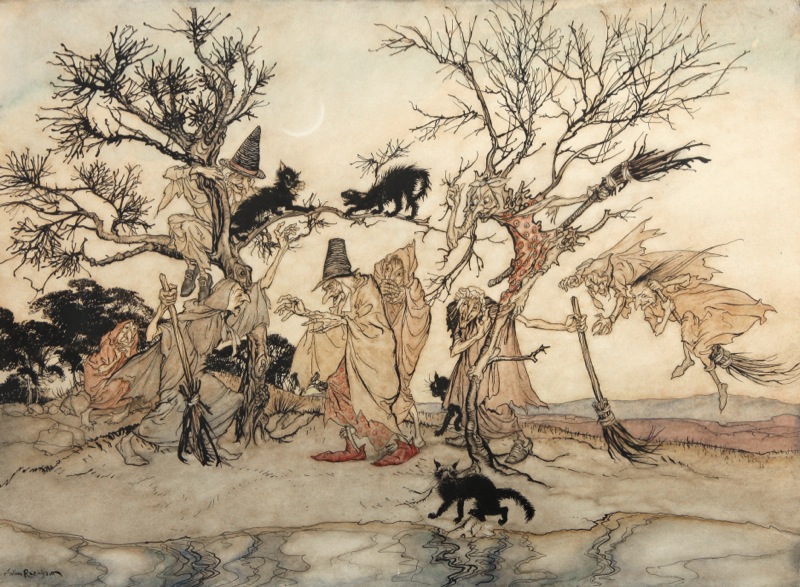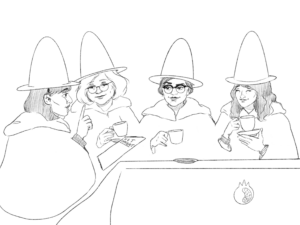Footnotes:
Editor’s note: Today’s episode contains content about psychedelics and, uh, unusual suppositories — so, potentially NSFW for some folks!
Why do witches ride brooms? How did crones and cleaning tools become one iconic trope? It’s a story filled with drugs, demons, and bread. Get ready for a lesson in hagriculture.
When you hear the word “witch,” the first thing that probably pops into your head is the stereotypical, Halloween-decoration version of the witch: An ugly old lady. Cackling. Deformed. Flying on her broomstick. It’s easy to forget that “wicked” and “old” are recent adjectives in the witch’s long history.

Think back to stories of witch trials where the threat of witchcraft seemed genuine and tangible to the people involved. Often, the accused was just a regular person. Usually, it was a woman, and someone who might’ve been a neighbor. The panic had a tendency to spring from the idea that wickedness hides in all of us, and so the earliest known depictions of witches illustrate woman who look just like anyone else:

As it turns out, that paranoia over what neighbors got up to when no one else was watching might have had a little push. For a pretty sizable chunk of western history, people used a type of wheat called rye in their bread, flour, alcohol, and just about anything else they ate. Unfortunately, rye was prone to a fungus infection called ergot. Today, we know that ergot can produce a high that includes increased paranoia and vivid hallucinations. For the victims who consumed the infected wheat, though, those hallucinations may have translated into sightings of dark magic.

But there were a few savvy folks who recognized the high for what it was. They set out to tame the fungus, looking to eliminate the deadliness while keeping the psychedelic effects at maximum strength. Tenacity would win out. Eventually, someone figured out that the plants could be mashed into a paste and absorbed through the skin to produce a high on par with LSD. The most effective way to absorb it? Through the mucus membranes of the rectum and/or genitals.
A few historical accounts of witches over the centuries seem to indicate that women accused of witchcraft were in frequent possession of a similar, more powerful balm that was mixed with other hallucinogenic plants. Some accounts even tell of women skipping around with staffs or brooms tucked between their legs, which they’d presumably used to apply the drugs.
It’s difficult to say how much of these descriptions is speculation, but to the church, the broom already carried a degree of scandal in its own right. The idea that women were expected to spend so much time with a seemingly phallic object during their daily routine was enough to make the story sound plausible.

Thus began the transformation of the broom-riding witch. Medieval engravings and artwork began to crop up showing nude women posed with their brooms, sometimes engaged in black magic. As more physicians and naturalists of the era studied the so-called potions, they learned that they induced a euphoric high that was likened to flying, so this aspect was incorporated into the images of the day. During the Renaissance, the depictions got more explicit, showing witches engaged in sexual acts, consorting with demons, or outright flying through the air on their broomsticks.

Later, as the Protestant Reformation got underway and hellfire and brimstone religion made a strong comeback, witches developed a reputation for being the playthings of the Devil himself and for drawing power directly from him. The witch had made the transition to full-blown evil. As time went on though, our knowledge of the world grew and the list of things that would send a person to hell shrank. Pagan beliefs were adapted to fit western-centric views and holidays, and witches faded into the realm of folklore, becoming more of a tool for frightening children than certified servants of Satan.

The ordinary women burned at the stake, domestically-inclined wives and neighbors whose crimes were often little more than unpopularity in their hometowns, were forgotten by history. In their place rose a mascot for selling candy: a wicked old witch, as twisted and gnarled as the story connecting the witch and the broom.

Sources:
A Bewitching History: Why Witches Ride Broomsticks by Megan Gannon. LiveScience.
Why Do Witches Ride Brooms? (NSFW) by Megan Garber. The Atlantic.
The Fascinating Reason Witches are Commonly Depicted Flying on Broomsticks. Today I Found Out.
Depraved Depictions of Witches in Early Modern Europe by Elizabeth Polk. Women In European History.
Museum Management:
Museum theme by Michael Guy Bowman
Listen to more at: bowman.bandcamp.com
Rachel: Designer #UkuleleWitch @rachelvice
Tour Guide: Emery Coolcats
Twitter: @natmysterycast | Email: natmysterypodcast@gmail.com | Home: pome-mag.com/category/pomecast
Museum of Natural Mystery is part of the POMEcast network, and thanks a million to the ladies of POME for helping this show get up and running! But above all, thank you for listening! We’ll see you next time!




